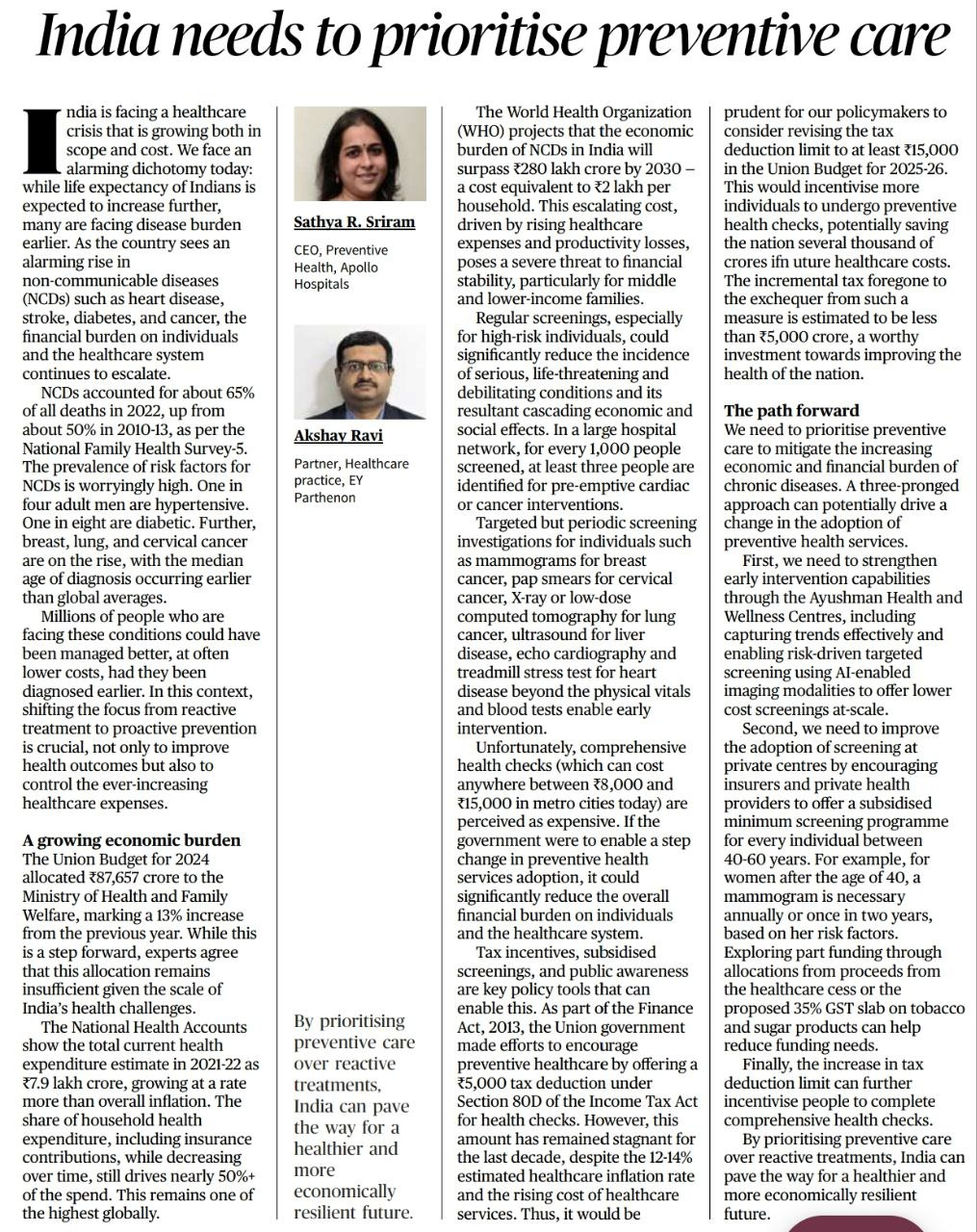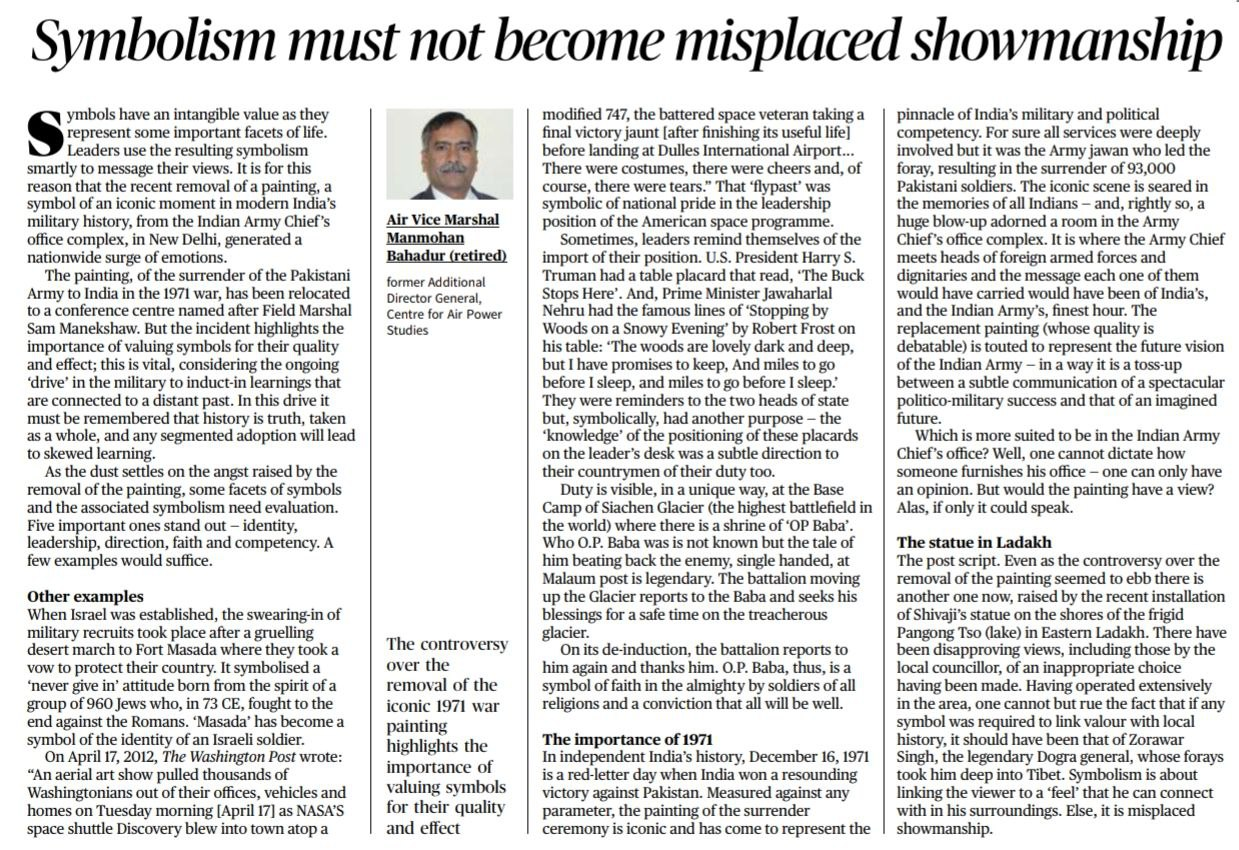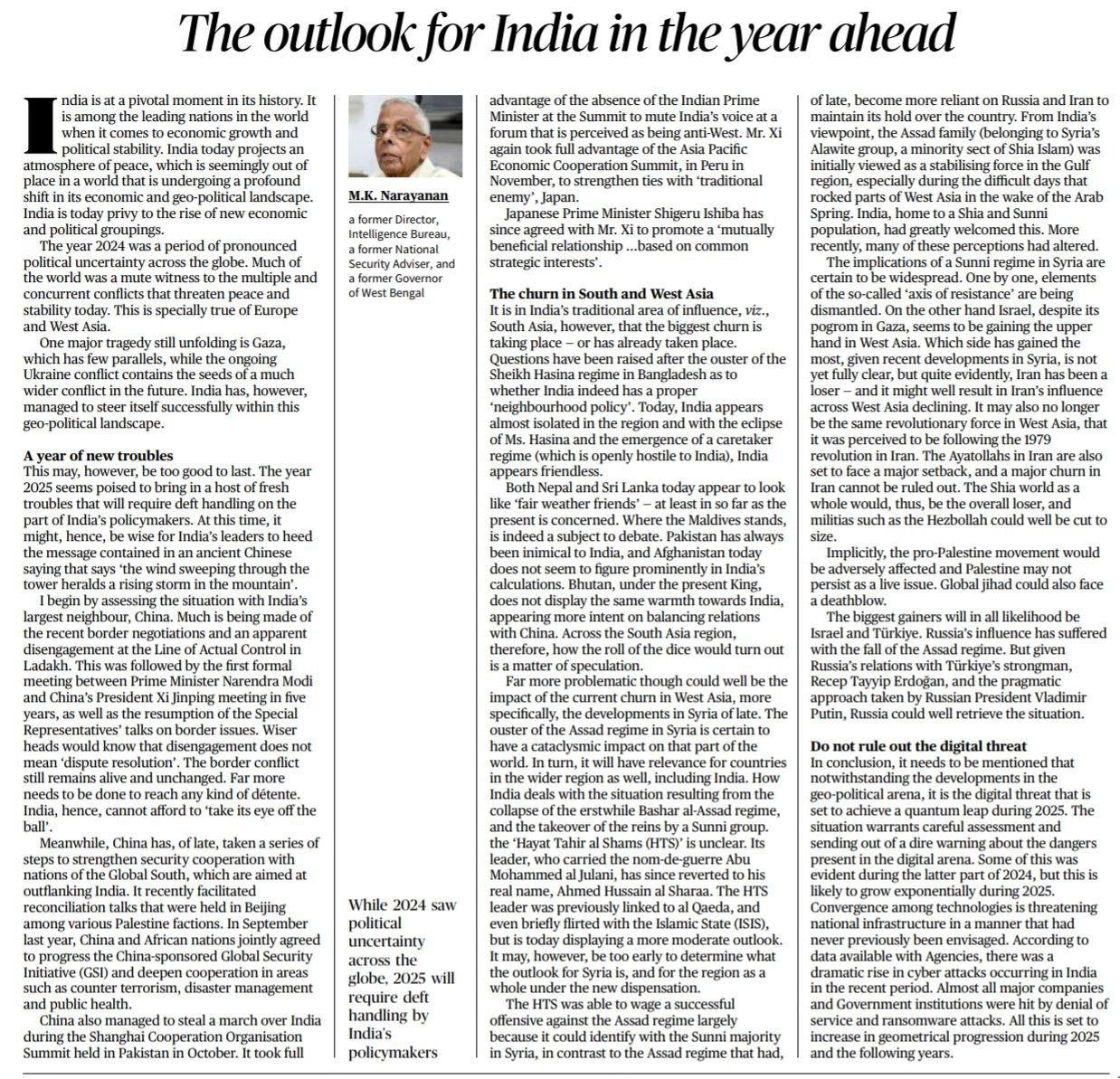1. Preventive Healthcare in India
Introduction
India is grappling with a growing healthcare crisis characterized by an alarming rise in non-communicable diseases (NCDs) such as heart disease, diabetes, and cancer. These diseases account for a significant portion of deaths and impose a heavy financial burden on individuals and the healthcare system. This highlights the urgent need for a paradigm shift from reactive treatments to preventive healthcare.
- Current Scenario
- NCDs account for 65% of all deaths in India (2022) compared to 50% in 2010.
- Risk factors for NCDs, like hypertension (one in four adults) and diabetes (one in ten adults), are prevalent.
- Breast, lung, and cervical cancers are on the rise, with late diagnosis worsening outcomes.
- Economic Impact
- India’s healthcare expenditure in 2021-22 stood at ₹7.9 lakh crore, growing faster than inflation, yet remains below global standards.
- Rising healthcare costs could amount to ₹2 lakh per household by 2030, as per WHO projections.
- Challenges
- Low awareness and adoption of preventive measures.
- High costs of diagnostic tests (₹8,000-15,000 in metro cities) act as barriers.
- Tax incentives and subsidies have been insufficient to promote preventive healthcare.
- Path Forward
- Policy Interventions:
- Increase tax deductions for preventive health checks (beyond ₹5,000 under Section 80D).
- Utilize GST collections from tobacco and sugar products for preventive health funding.
- Screening and Early Detection:
- Encourage targeted screening for high-risk individuals (e.g., mammograms, X-rays, cardiac stress tests).
- Leverage AI-enabled screening tools for cost-efficient diagnostics.
- Public Awareness and Subsidies:
- Strengthen the Ayushman Bharat Health and Wellness Centres.
- Subsidize health checks for individuals in the 40-60 age group.
- Policy Interventions:
Conclusion
Shifting focus to preventive care is imperative to curb the escalating disease burden and healthcare costs in India. A three-pronged approach involving awareness, policy reforms, and technological advancements can foster a healthier and economically resilient population.
Mains Practice Question |
Q. “India’s healthcare challenges stem from insufficient focus on preventive care.” Critically analyze this statement. Suggest measures to improve the adoption of preventive healthcare in India. |
2. Symbolism in Leadership and Governance
Introduction
Symbolism plays an essential role in leadership and governance, representing national values, pride, and identity. However, misplaced or excessive reliance on symbolism can lead to skewed perceptions and fail to address substantive issues. The recent controversy over the removal of the iconic 1971 war painting from the Army Chief’s office raises pertinent questions about the balance between symbolism and substance.
- Role of Symbolism
- Reflects national pride and historical achievements.
- Acts as a reminder of duties and responsibilities in leadership.
- Inspires collective memory, as seen in the 1971 surrender ceremony painting symbolizing India’s military success.
- Examples of Symbolism
- India:
- The shrine of “OP Baba” at Siachen Glacier symbolizes soldiers’ faith and unity.
- The 1971 war painting represents the valor of Indian soldiers during the Bangladesh Liberation War.
- Global Examples:
- Israel’s use of Masada as a symbol of resilience and identity.
- The U.S. President’s desk plaque, “The Buck Stops Here,” emphasizing accountability.
- India:
- Challenges of Misplaced Symbolism
- Misaligned focus: Overemphasis on symbolic gestures can detract from core governance and leadership values.
- Controversy: The relocation of significant symbols (e.g., the 1971 war painting) may alienate stakeholders and spark public debate.
- Lack of contextual understanding: Symbolism without historical or cultural alignment (e.g., Shivaji’s statue near Pangong Tso) may fail to resonate with local communities.
- Way Forward
- Balanced Approach: Symbolism should complement, not substitute, effective governance.
- Stakeholder Involvement: Decisions about national symbols should involve diverse perspectives to avoid alienation.
- Contextual Relevance: Historical and cultural contexts must be respected when adopting or modifying symbols.
Conclusion
Symbols hold immense intangible value, serving as markers of national identity and pride. However, their effectiveness lies in thoughtful adoption, ensuring they align with leadership objectives and public sentiment. Misplaced showmanship risks diluting their significance, underscoring the need for a balanced approach to preserve their integrity and purpose.
Mains Practice Question |
Q. “Symbols are a powerful tool for leadership, but misplaced symbolism can weaken their intended impact.” Discuss this statement with suitable examples. |
3. India’s Geopolitical and Economic Outlook for 2025
Introduction
India stands at a critical juncture in its history, emerging as a global leader in both economic growth and political stability. As the world grapples with shifting alliances, regional conflicts, and a volatile geopolitical environment, India must navigate these challenges while capitalizing on its growing influence in international forums.
Global Geopolitical Landscape
- Major Conflicts:
- The ongoing war in Ukraine and the Gaza crisis highlight global instability, particularly in Europe and West Asia.
- The potential for escalations in these conflicts remains a critical concern for global peace.
- Rise of New Groupings:
- Regional alignments, such as China’s role in the Global South and the Asia-Pacific Economic Cooperation (APEC) Summit, indicate a shift in global power dynamics.
- India’s Immediate Challenges
- Border Issues with China:
- Recent negotiations have reduced tensions but failed to resolve long-standing disputes.
- Disengagement along the Line of Actual Control (LAC) remains incomplete.
- Neighborhood Relations:
- Political uncertainty in Bangladesh, particularly the future of the Sheikh Hasina government, poses challenges to India’s “Neighborhood First” policy.
- Sri Lanka’s “fair-weather” diplomacy and Pakistan’s instability add complexity to South Asian dynamics.
- Border Issues with China:
- Key Regional Concerns
- West Asia:
- The fall of the Assad regime in Syria could reshape power dynamics, affecting India’s energy security and diaspora safety.
- South Asia:
- Afghanistan’s future remains uncertain, complicating regional security cooperation.
- West Asia:
- Digital Threats
- Increased cyberattacks on critical infrastructure in India underscore the urgent need for a robust cybersecurity framework.
- Investments in technological advancements, including AI, must be prioritized to counter emerging threats.
- Way Forward
- Strengthening Diplomacy:
- Engage more actively in forums like G20 and BRICS to shape global governance.
- Build strategic partnerships with key nations, including Japan, the EU, and Gulf countries.
- Internal Reforms:
- Focus on digital infrastructure to enhance cybersecurity.
- Boost defense modernization to address external and internal security concerns.
- Strengthening Diplomacy:
Conclusion
As India steps into 2025, it must balance its aspirations as a global leader with the need to address regional and domestic challenges. By adopting a pragmatic foreign policy and investing in critical infrastructure, India can navigate the evolving geopolitical landscape while securing its position as a stable and resilient power.
Mains Practice Question |
Q. “India’s global outlook in 2025 hinges on its ability to balance geopolitical ambitions with regional and domestic challenges.” Discuss. |




